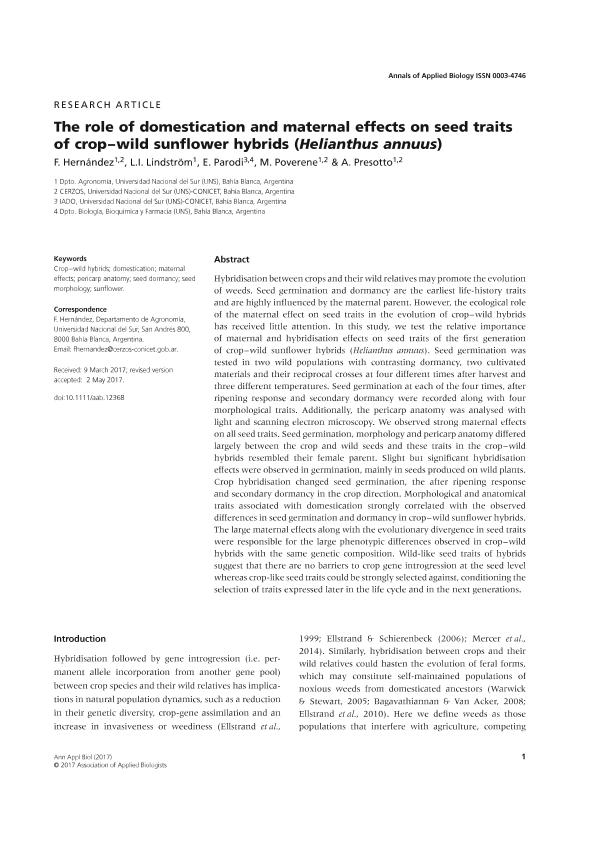Mostrar el registro sencillo del ítem
dc.contributor.author
Hernández, Fernando

dc.contributor.author
Lindström, Lilia Ivone

dc.contributor.author
Parodi, Elisa Rosalia

dc.contributor.author
Poverene, María Mónica

dc.contributor.author
Presotto, Alejandro Daniel

dc.date.available
2018-01-29T14:24:53Z
dc.date.issued
2017-08-18
dc.identifier.citation
Hernández, Fernando; Lindström, Lilia Ivone; Parodi, Elisa Rosalia; Poverene, María Mónica; Presotto, Alejandro Daniel; The role of domestication and maternal effects on seed traits of crop–wild sunflower hybrids (Helianthus annuus); Wiley; Annals of Applied Biology; 171; 2; 18-8-2017; 237-251
dc.identifier.issn
0003-4746
dc.identifier.uri
http://hdl.handle.net/11336/34835
dc.description.abstract
Hybridization between crops and their wild relatives may promote the evolution of weeds. Seed germination and dormancy are the earliest life-history traits and are highly influenced by the maternal parent. However, the ecological role of the maternal effect on seed traits in the evolution of crop-wild hybrids has received little attention. In this study, we test the relative importance of maternal and hybridization effects on seed traits of the first generation of crop-wild sunflower hybrids (Helianthus annuus). Seed germination was tested in two wild populations with contrasting dormancy, two cultivated materials and their reciprocal crosses at four different times after harvest and three different temperatures. Seed germination at each of the four times, after ripening response and secondary dormancy were recorded along with four morphological traits. Additionally, the pericarp anatomy was analysed with light and scanning electron microscopy. We observed strong maternal effects on all seed traits. Seed germination, morphology and pericarp anatomy differed largely between the crop and wild seeds and these traits in the crop-wild hybrids resembled their<br />female parent. Slight but significant hybridization effects were observed in germination, mainly in seeds produced on wild plants. Crop hybridization changed seed germination, the after ripening response and secondary dormancy in the crop direction. Morphological and anatomical traits associated with domestication strongly correlated with the observed differences in seed germination and dormancy in crop-wild sunflower hybrids. The large maternal effects along with the evolutionary divergence in seed traits were responsible for the large phenotypic differences observed in crop-wild hybrids with the same genetic composition. Wild-like seed traits of hybrids suggest that there are no barriers to crop gene introgression at the seed level whereas crop-like seed traits could be strongly selected against, conditioning the selection of traits expressed later in the life cycle and in the next generations.
dc.format
application/pdf
dc.language.iso
eng
dc.publisher
Wiley

dc.rights
info:eu-repo/semantics/openAccess
dc.rights.uri
https://creativecommons.org/licenses/by-nc-sa/2.5/ar/
dc.subject
Sunflower
dc.subject
Crop-Wild Hybrids
dc.subject
Maternal Effects
dc.subject
Seed Dormancy
dc.subject.classification
Agricultura

dc.subject.classification
Agricultura, Silvicultura y Pesca

dc.subject.classification
CIENCIAS AGRÍCOLAS

dc.title
The role of domestication and maternal effects on seed traits of crop–wild sunflower hybrids (Helianthus annuus)
dc.type
info:eu-repo/semantics/article
dc.type
info:ar-repo/semantics/artículo
dc.type
info:eu-repo/semantics/publishedVersion
dc.date.updated
2017-10-26T14:41:21Z
dc.journal.volume
171
dc.journal.number
2
dc.journal.pagination
237-251
dc.journal.pais
Estados Unidos

dc.journal.ciudad
Hoboken
dc.description.fil
Fil: Hernández, Fernando. Universidad Nacional del Sur. Departamento de Agronomía; Argentina. Consejo Nacional de Investigaciones Científicas y Técnicas. Centro Científico Tecnológico Conicet - Bahía Blanca. Centro de Recursos Naturales Renovables de la Zona Semiárida. Universidad Nacional del Sur. Centro de Recursos Naturales Renovables de la Zona Semiárida; Argentina
dc.description.fil
Fil: Lindström, Lilia Ivone. Universidad Nacional del Sur. Departamento de Agronomía; Argentina
dc.description.fil
Fil: Parodi, Elisa Rosalia. Universidad Nacional del Sur. Departamento de Biología, Bioquímica y Farmacia; Argentina. Consejo Nacional de Investigaciones Científicas y Técnicas. Centro Científico Tecnológico Conicet - Bahía Blanca. Instituto Argentino de Oceanografía. Universidad Nacional del Sur. Instituto Argentino de Oceanografía; Argentina
dc.description.fil
Fil: Poverene, María Mónica. Universidad Nacional del Sur. Departamento de Agronomía; Argentina. Consejo Nacional de Investigaciones Científicas y Técnicas. Centro Científico Tecnológico Conicet - Bahía Blanca. Centro de Recursos Naturales Renovables de la Zona Semiárida. Universidad Nacional del Sur. Centro de Recursos Naturales Renovables de la Zona Semiárida; Argentina
dc.description.fil
Fil: Presotto, Alejandro Daniel. Universidad Nacional del Sur. Departamento de Agronomía; Argentina. Consejo Nacional de Investigaciones Científicas y Técnicas. Centro Científico Tecnológico Conicet - Bahía Blanca. Centro de Recursos Naturales Renovables de la Zona Semiárida. Universidad Nacional del Sur. Centro de Recursos Naturales Renovables de la Zona Semiárida; Argentina
dc.journal.title
Annals of Applied Biology

dc.relation.alternativeid
info:eu-repo/semantics/altIdentifier/url/http://onlinelibrary.wiley.com/doi/10.1111/aab.12368
dc.relation.alternativeid
info:eu-repo/semantics/altIdentifier/doi/http://dx.doi.org/10.1111/aab.12368
Archivos asociados
